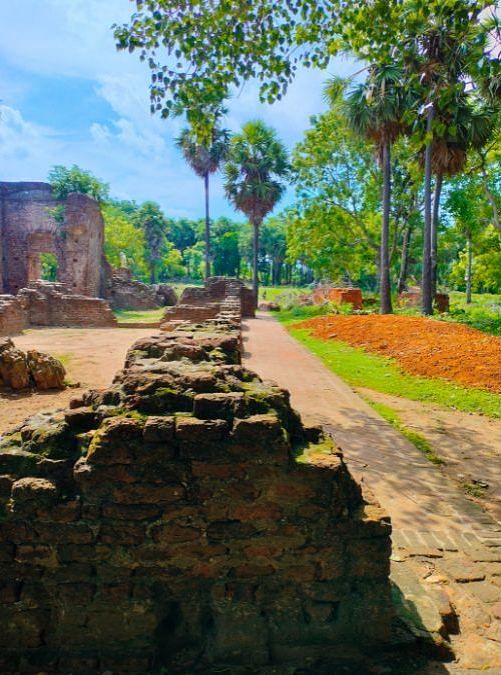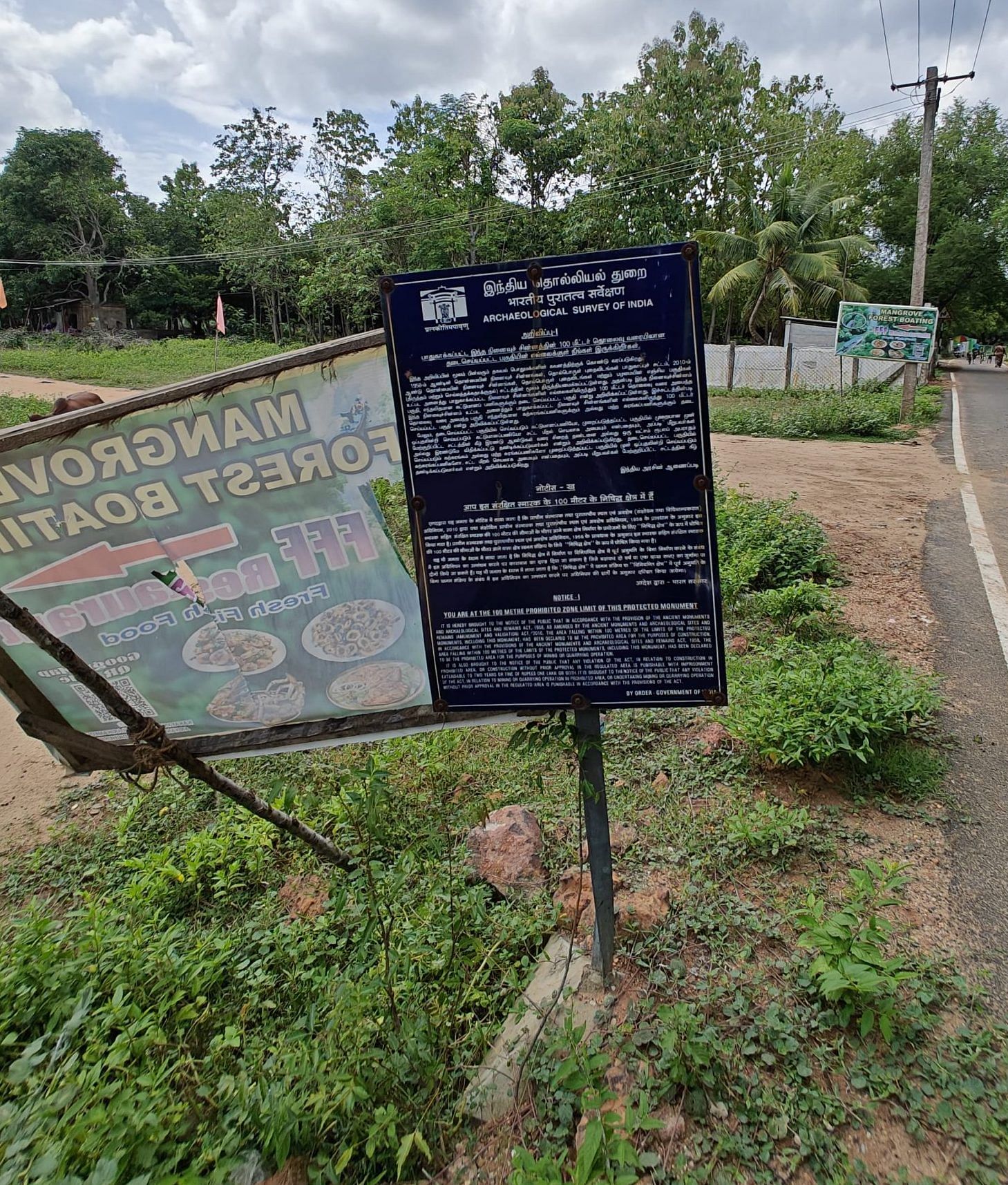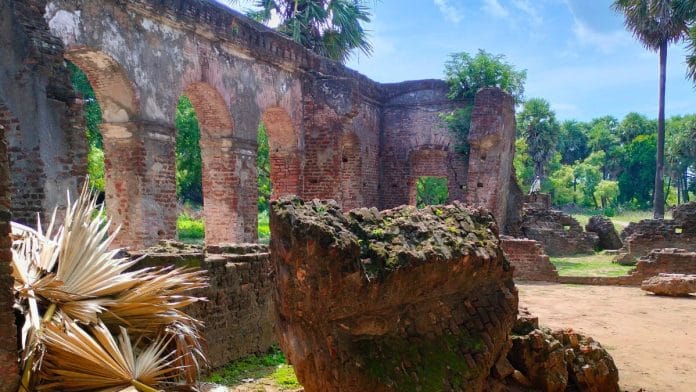Excavations breathe life into ancient sites, resurrecting forgotten histories and uncovering stories hidden beneath the earth. Archaeologists use their tools to unearth these treasures, but once the excavation is complete and data gathered, the site is reburied—returned to its original state as per global standard practice. Ultimately, the fate of these sites rests with authorities and government agencies tasked with their protection, but too often, after being reburied, they fade into obscurity once more. Such is the case with Arikamedu, an ancient port city on the southeastern coast near Puducherry.
Today, on the isolated Arikamedu Road, a lone signboard marks the site’s protected status—ignored by all but the passing goats and cattle. With no clear signage, no guidance to the site, and no local awareness, the site is in danger of being forgotten entirely.
Unearthing Arikamedu
Buried between Veerampattinam beach in the east and Ariyankuppam river in the west are the remains of the ancient port city of ‘Podouke’, which was mentioned in the mid-first century manuscript Periplus of the Erythraean Sea. Today this place is known as Arikamedu—one of the most significant archaeological sites in southern India. It’s a defining feature of east coast maritime trade, especially the Indo-Roman trade, which lasted for two centuries or more.
The site of Arikamedu was first mentioned by French astronomer Guillaume Le Gentil in his travel writings in 1768-71. He mentioned the presence of high walls and large tanks at the sites along with a large embankment along the riverside. But it was only in 1941 that interest in the site was renewed, when French archaeologist G Jouveay Dubreuil identified the site with the ancient port city of ‘Podouke’. This initial digging did yield some interesting artefacts—beads, gems and one bead with the head of Augustus in intaglio. It fascinated many French residents in the area, who started excursions to the site in a personal capacity. Most of these endeavours were unscientific and antiquarian, the emphasis was on artefacts not the reconstruction of the past. That was the case until Mortimer Wheeler took over as the Director General of ASI.
The excavation at Arikamedu in 1945 was Wheeler’s first project in India after he was appointed to the ASI post the previous year. The site was already in a poor state due to mindless robbing by enthusiasts and disturbance caused by rice and coconut cultivation, but he ended up identifying interesting features like the warehouse. This structure, made of bricks and lime mortar, was over 45 m in length, with a single partition wall and side chamber towards the east. His excavation also yielded three types of pottery which became the datum point for relative dating in southern India. The first, the Arretine Ware, which is a red-glazed stamped potter of Mediterranean origin, was found in the form of a footed base and dish. The second was Amphorae, high-necked handled jars used by Romans to store wine or oil. And the third is the Rouletted Ware, a dish with an incurved and beaked rim with faceted edges. The pottery was usually black or grey in colour and a significant feature was the base, which was decorated in a rouletted design. Beside these, Chinese Celadon Ware, red and black ware and local grey pottery was found.

Wheeler also uncovered a range of other material culture from the Roman world, including glass beads, terracotta figurines, and Roman coins, which further solidified the site’s importance as a commercial hub. He suggested that the city has two distinct yet related parts—North and South. The northern part was used as the harbour and the southern part was the industrial town. He dated the site to 1st c. BCE to 100 CE and was of the opinion that the site thrived only for two hundred years—a notion which was discredited in the following excavation by Jean-Marie Casal from 1947 to 1950.
Casal pointed toward a strong connection between Arikamedu and the Megalithic burials at Suthukeny. Moreover, large quantities of Black and Red Ware linked to the Iron Age and Medieval pottery suggest the site was in continuous occupation all the way into the medieval period during Chola reign and beyond. Casal also found textile dyeing tanks, pozzolana cement and sigillata sherds.
After 40 years the site was re-excavated by Professor Vimala Bagley in 1989-1992 who dated the southern settlement to 300 BCE and said that the northern portion was occupied till the medieval period. The re-excavation of the site suggested that it was re-occupied in the 18th century. The conclusion was that Arikamedu was a significant port from 300 BCE to 18th CE.
Also read: Lothal was a complex urban centre with maritime connections. It had a dockyard too
Forgotten and ignored
In 2004, at a conference jointly organised by the Pondicherry Administration and the Embassy of Italy, the governments decided to join hands in the matters of conservation of the site. It was proposed that, since the site is rich in cultural history and depicts an important chapter in the history of relations between Italy and India, it should be proposed for the UNESCO World Heritage Site tag. The site has been under the protection of the Archaeological Survey of India since 1982. The ASI was also a stakeholder in this proposition of nominating the site for UNESCO status under the Silk Route Sites in India project.
To make matters easy, ASI acquired the 34-57 acres of land that was Arikamedu and formulated a master plan for the site. It also decided to excavate the site, conserve old trenches for display and create a site museum. However, 20 years after this announcement the site is still neglected. It doesn’t exist in the eyes of the local residents nor is it a part of the tourism circuit.
The drive from Puducherry to Arikamedu is just a few kilometres along Arikamedu Road. However, once you’re on this road, there are no signs directing you to the site. A narrow, dusty path leads you through a forested area, and after a few kilometres, you come across a solitary ASI board marking the site’s protected status.

With no one in sight, the only remnants of the past are the crumbling ruins to the left, a silent testament to the history revived here decades ago. No site, especially one as historically significant as Arikamedu, deserves such neglect. One can’t help but wonder: would the situation be different if the site held any political or religious interest for the authorities?
Disha Ahluwalia is an archaeologist and junior research fellow at the Indian Council Of Historical Research. Views are personal. She tweets @ahluwaliadisha.
(Edited by Theres Sudeep)







Tamil Nadu is oxymoron. A casteless social justice society where people vote for thier own caste and ‘lower’ castes supress other lower castes. Lies pervade and DMK rules using these lies and bad mouthing rest of India. Luck and inherited benefits from previous rulers governing well. No government will promote local culture. Only their own convenient lies.
Nationalism has always been suppressed or distorted by modern rulers. Especially the ones claiming liberal tendencies. They fear that if the past appears better or past ruler appear as role models to compare themselves to, the people will not give them power any more. Even DMK claims of focus on Tamil culture are really about focusing on what DMK icons are supposed to have done for people. The pure selfishness and hypocrisy of such politicians aided and abetted by so called academics seeking benefits from the ruling dispension is the cause of this neglect. ‘Religious importance’ was a veiled reference to BJP. But there is utter refusal to acknowledge the flaws of any left wing governments.